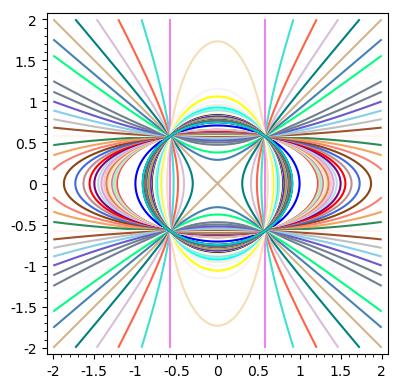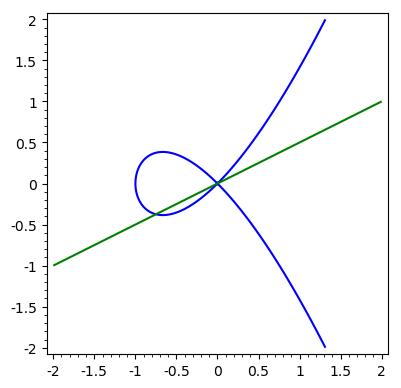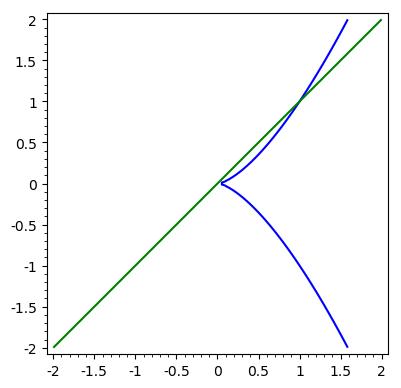
Announcement, March 16:
Since the College has sent students home and instruction is to continue at a distance, I will be switching all this material to Moodle. Then I will start posting materials there for you to use.
One thing you can do now is check whether you can access this course's Moodle page. If you have problems, please email me as soon as you can.
This page is for materials for MA434. Here is the course syllabus.
Presentation assignments are approximate, because it may well turn out that something will take more (or less) time. The link between section of the book and presenters is firm; the link between them and a date may change. All references are to Miles Reid’s Undergraduate Algebraic Geometry.
An introduction to Sage and GP.
| Scribal Notes | In Class |
| February 5: Woffle | |
| February 7: Notes by Simon | February 7: Fernando: 1.1–1.3; you might also want to read about the twisted cubic. |
| February 10: Notes by Christopher | February 10: Fernando: 1.4–1.6. This book review includes some interesting pictures that help visualize the projective plane. (If anyone can produce the Sage code to make such pictures I’d love to have it.) |
| February 12: Notes by Terry | February 12: Fernando: 1.7–1.8 |
| February 14: Notes by Joshua | February 14: Lanie and Annie: 1.9–1.11 |
| February 17: Notes by Lily | February 17: Terry and Simon 1.12–1.14. See below for a picture of a pencil of conics. |
| February 19: Notes by Ethan | February 19: Problem day: look at problems 1.6, 1.7, 1.8, 1.10, 1.11 |
| February 21: Notes by Lanie | February 21: Jeremy and Maitri: 2.1–2.3. See below for how to parametrize a singular cubic. |
| February 24: Notes by Jack | February 24: Joshua and Ethan: 2.4–2.7 |
| February 26: Notes by Annie | February 26: Jack and Nathaniel: 2.8–2.10 |
| February 28: Notes by Nathaniel | February 28: William and Schu: 2.12 and examples from Exercises 2.3–2.6 |
| March 2: Notes by Schu | March 2: Fernando on genus |
| March 4: Notes by Xander | March 4: Problem Day 2. |
| March 6: Notes by Maitri | March 6: Huan and Xander: 3.1–3.2 |
| March 9: Notes by Huan | March 9: Lily and Christopher: 3.3 and 3.4–3.6 Midterm Exam starts |
| March 11: Notes by Jeremy | March 11: Fernando: 3.7–3.9 |
| March 13: Notes by William | March 13: Fernando: 3.8–3.10 Midterm Exam Ends |
| March 16: Notes by | March 16: Jeremy and Lily: 3.11 and examples |
| March 18: Notes by | March 18: Annie and Schu: 3.12–3.14 |
| March 20: Notes by | March 20: Problem day |
| March 23–27: Spring Break | |
| March 30: | March 30: William and Xander: 3.14–3.17 |
| April 1: | April 1: Maitri and Lanie: |
| April 3: | April 3: Ethan and Christopher: |
| April 6: | April 6: Joshua and Terry: |
| April 8: | April 8: Nathaniel and Simon: |
| April 10: | April 10: Huan and Jack: |
| April 13: | April 13: |
| April 15: | April 15: |
| April 17: | April 17: |
| April 20: | April 20: |
| April 22: | April 22: |
| April 24: | April 24: |
| April 27: | April 27: |
| April 29: | April 29: |
| May 1: Lost to CLAS | |
| May 4: | May 4: |
| May 6: | May 6: |
| May 8: | May 8: |
A Pencil of conics.
I asked Sage to do this:
var('x y t')
Q(t)=(2+t)*x^2+(1+2*t)*y^2-(1+t)
G=implicit_plot(x^2+2*y^2-1==0,(x,-2,2),(y,-2,2))
for c in range(-40,40):
G += implicit_plot(Q(c/10)==0,(x,-2,2),(y,-2,2),color=sorted(colors)[c%147])
show(G)
So Q(t) is the affine part of the pencil defined by the two ellipses that
we discussed in class. The first "implicit_plot" is the plot for
t=infinity, and then the for command adds a bunch of other plots. This is
what we get:

It’s not a bad idea to ponder that picture.
Here is an animated version made by Joshua with the Desmos calculator. Play with the sliders!
Parametrizing a Singular Cubic.
The idea for finding the parametrizations of nodal and cuspidal cubics is the same as for conics, except that you need to use the singular point to draw the one-parameter family of lines. In our examples the singular point was (0,0), so the lines are just y=tx. See the pictures below. Try it!

